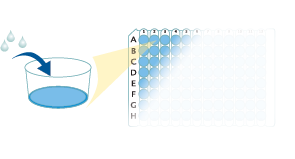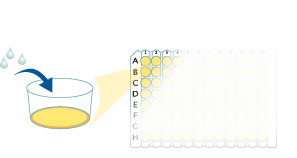Mouse RAGE Quantikine ELISA Kit Summary
Product Summary
Precision
Cell Culture Supernates, Tissue Lysates, Serum, EDTA Plasma, Heparin Plasma, Urine
| Intra-Assay Precision | Inter-Assay Precision | |||||
|---|---|---|---|---|---|---|
| Sample | 1 | 2 | 3 | 1 | 2 | 3 |
| n | 20 | 20 | 20 | 20 | 20 | 20 |
| Mean (pg/mL) | 66.1 | 236 | 518 | 68.8 | 242 | 559 |
| Standard Deviation | 5.02 | 14.5 | 24.3 | 5.44 | 13.4 | 32.6 |
| CV% | 7.6 | 6.1 | 4.7 | 7.9 | 5.5 | 5.8 |
Recovery
The recovery of mouse RAGE spiked to three levels throughout the range of the assay in various matrices was evaluated.
| Sample Type | Average % Recovery | Range % |
|---|---|---|
| Cell Culture Samples (n=4) | 108 | 94-120 |
| EDTA Plasma (n=4) | 101 | 87-118 |
| Heparin Plasma (n=4) | 111 | 96-120 |
| Serum (n=4) | 107 | 90-117 |
| Tissue Lysates (n=4) | 103 | 91-120 |
| Urine (n=4) | 109 | 96-120 |
Linearity
Scientific Data
Product Datasheets
Preparation and Storage
Background: RAGE/AGER
RAGE (Receptor for Advanced Glycation End product) is a transmembrane glycoprotein that binds advanced glycation end products (AGEs), beta-amyloid peptides, HMGB1/Amphoterin, and several S100 family proteins. AGEs are adducts formed by the non-enzymatic glycation and oxidation of proteins and lipids. A soluble form can also be generated by MMP-mediated shedding. RAGE is expressed in the CNS during development as well as in adult endothelial cells, smooth muscle cells, pericytes, monocytes, and neurons. It is locally upregulated in vascular inflammation (e.g. diabetes, atherosclerosis, vascular injury, Alzheimer’s disease). At these sites, RAGE binding to S100A1, EN-RAGE/S100A12, or S100B induces inflammatory immune cell adhesion and infiltration as well as vascular smooth muscle proliferation, neointimal expansion, atherosclerotic plaque development, and transport of A-beta into the cerebrospinal fluid. In cancer, RAGE binding to HMGB1, S100A8, or S100A9 promotes tumor growth and metastasis in addition to inflammatory cell infiltration.
To view our complete solutions for RAGE research, visit bio-techne.com.
Assay Procedure
Refer to the product- Prepare all reagents, standard dilutions, and samples as directed in the product insert.
- Remove excess microplate strips from the plate frame, return them to the foil pouch containing the desiccant pack, and reseal.
- Add 50 µL of Assay Diluent to each well.
- Add 50 µL of Standard, Control, or sample to each well. Cover with a plate sealer, and incubate at room temperature for 2 hours on a horizontal orbital microplate shaker.
- Aspirate each well and wash, repeating the process 3 times for a total of 4 washes.
- Add 100 µL of Conjugate to each well. Cover with a new plate sealer, and incubate at room temperature for 2 hours on the shaker.
- Aspirate and wash 4 times.
- Add 100 µL Substrate Solution to each well. Incubate at room temperature for 30 minutes on the benchtop. PROTECT FROM LIGHT.
- Add 100 µL of Stop Solution to each well. Read at 450 nm within 30 minutes. Set wavelength correction to 540 nm or 570 nm.





Citations for Mouse RAGE Quantikine ELISA Kit
R&D Systems personnel manually curate a database that contains references using R&D Systems products. The data collected includes not only links to publications in PubMed, but also provides information about sample types, species, and experimental conditions.
13
Citations: Showing 1 - 10
Filter your results:
Filter by:
-
Biological Effects of Corticosteroids on Pneumococcal Pneumonia in Mice and Humans
Authors: Taenaka, H;Wick, KD;Sarma, A;Matsumoto, S;Ghale, R;Fang, X;Maishan, M;Gotts, JE;Langelier, CR;Calfee, CS;Matthay, MA;
Research square
Species: Mouse
Sample Types: BALF
-
Effects of sevoflurane on lung epithelial permeability in experimental models of acute respiratory distress syndrome
Authors: Zhai, R;Lenga Ma Bonda, W;Leclaire, C;Saint-Béat, C;Theilliere, C;Belville, C;Coupet, R;Blondonnet, R;Bouvier, D;Blanchon, L;Sapin, V;Jabaudon, M;
Journal of translational medicine
Species: Mouse
Sample Types: BALF, Cell Culture Supernates
-
NETs Promote Inflammatory Injury by Activating cGAS-STING Pathway in Acute Lung Injury
Authors: J Zhao, N Zhen, Q Zhou, J Lou, W Cui, G Zhang, B Tian
International Journal of Molecular Sciences, 2023-03-07;24(6):.
Species: Mouse
Sample Types: Serum
-
Impairing RAGE signaling promotes survival and limits disease pathogenesis following SARS-CoV-2 infection in mice
Authors: F Jessop, B Schwarz, D Scott, LM Roberts, E Bohrnsen, JR Hoidal, CM Bosio
JCI Insight, 2022-01-25;7(2):.
Species: Mouse
Sample Types: Tissue Homogenates
-
Fermented rice bran supplementation attenuates chronic colitis-associated extraintestinal manifestations in female C57BL/6N mice
Authors: J Islam, AZ Agista, K Watanabe, T Nochi, H Aso, Y Ohsaki, T Koseki, M Komai, H Shirakawa
The Journal of nutritional biochemistry, 2021-09-10;0(0):108855.
Species: Mouse
Sample Types: Serum
-
ADAM10 attenuates the development of abdominal aortic aneurysms in a mouse model
Authors: Q Renfeng, C Shuxiao, G Peixian, L Kun, F Xuedong, Y Hai, W Xuejun, L Gang
Molecular Medicine Reports, 2021-09-07;24(5):.
Species: Mouse
Sample Types: Serum
-
Soluble Receptor for Advanced Glycation End-products regulates age-associated Cardiac Fibrosis
Authors: F Scavello, F Zeni, G Milano, F Macrì, S Castiglion, E Zuccolo, A Scopece, G Pezone, CC Tedesco, P Nigro, G Degani, E Gambini, F Veglia, L Popolo, G Pompilio, GI Colombo, ME Bianchi, A Raucci
International journal of biological sciences, 2021-06-11;17(10):2399-2416.
Species: Mouse
Sample Types: Serum
-
Inhibition of the Receptor for Advanced Glycation End Products Enhances the Cytotoxic Effect of Gemcitabine in Murine Pancreatic Tumors
Authors: P Swami, KA O'Connell, S Thiyagaraj, A Crawford, P Patil, P Radhakrish, S Shin, TC Caffrey, J Grunkemeye, T Neville, SW Vetter, MA Hollingswo, E Leclerc
Biomolecules, 2021-04-01;11(4):.
Species: Mouse
Sample Types: Cell Lysates
-
Alteration of oxidative-stress and related marker levels in mouse colonic tissues and fecal microbiota structures with chronic ethanol administration: Implications for the pathogenesis of ethanol-related colorectal cancer
Authors: H Ohira, A Tsuruya, D Oikawa, W Nakagawa, R Mamoto, M Hattori, T Waki, S Takahashi, Y Fujioka, T Nakayama
PLoS ONE, 2021-02-12;16(2):e0246580.
Species: Mouse
Sample Types: Tissue Homogenates
-
Change of surfactant protein D and A after renal ischemia reperfusion injury
Authors: IM Imtiazul, R Asma, JH Lee, NJ Cho, S Park, HY Song, HW Gil
PLoS ONE, 2019-12-26;14(12):e0227097.
Species: Mouse
Sample Types: Serum
-
RAGE inhibition reduces acute lung injury in mice
Authors: R Blondonnet, J Audard, C Belville, G Clairefond, J Lutz, D Bouvier, L Roszyk, C Gross, M Lavergne, M Fournet, L Blanchon, C Vachias, C Damon-Soub, V Sapin, JM Constantin, M Jabaudon
Sci Rep, 2017-08-03;7(1):7208.
Species: Mouse
Sample Types: Tissue Homogenates
-
The Mouse-Specific Splice Variant mRAGE_v4 Encodes a Membrane-Bound RAGE That Is Resistant to Shedding and Does Not Contribute to the Production of Soluble RAGE
PLoS ONE, 2016-09-21;11(9):e0153832.
Species: Mouse
Sample Types: Cell Culture Supernates
-
Mouse RAGE Variant 4 Is a Dominant Membrane Receptor that Does Not Shed to Generate Soluble RAGE
PLoS ONE, 2016-09-21;11(9):e0153657.
Species: Human, Mouse
Sample Types: Cell Culture Supernates, Serum
FAQs
No product specific FAQs exist for this product, however you may
View all ELISA FAQsReviews for Mouse RAGE Quantikine ELISA Kit
There are currently no reviews for this product. Be the first to review Mouse RAGE Quantikine ELISA Kit and earn rewards!
Have you used Mouse RAGE Quantikine ELISA Kit?
Submit a review and receive an Amazon gift card.
$25/€18/£15/$25CAN/¥75 Yuan/¥2500 Yen for a review with an image
$10/€7/£6/$10 CAD/¥70 Yuan/¥1110 Yen for a review without an image







